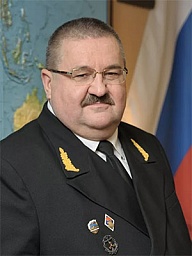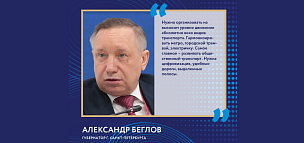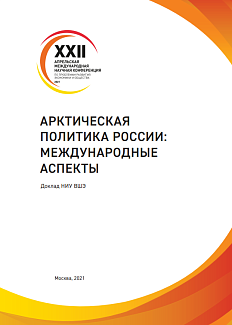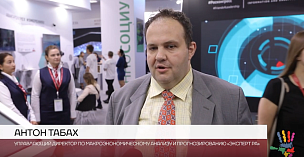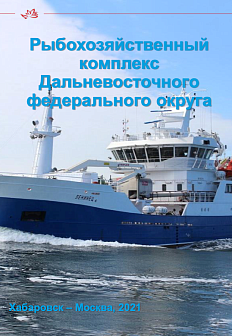Indeed, the way across the northern seas has been around for a long time. Some date it back to Mikhail Lomonosov, whose imagination was sparked by the idea. Others trace it to the 1930s, when the Soviet government threw enormous money and human lives into conquering the Arctic. However, all this is romance and history. If we talk about the establishment of the NSR as a regular transportation route, it is tied to the growth of the Norilsk Combine (now Nornickel) in the 1970s and 1980s. As its capacity grew, so grew its output: suddenly, everything could not be shipped in just the summer season. That was the beginning of a pressing need for a year-round transportation system from Dudinka to Murmansk. As a result, an entire fleet of Arctic-class cargo ships and a series of powerful icebreakers were built. The next leap forward in the growth of NSR will come about in this century, when the task went to Rosatom State Atomic Energy Corporation.
«Back in the best Soviet years, the flow of goods through the Northern Sea Route never exceeded 6.5 million tonnes, yet in 2018 we reached 20 million tonnes,» says Vyacheslav Ruksha, showing a diagram. Only, what he sees is not just the numbers. His vision covers icebreakers going through layers of frozen water, with nuclear- powered ships carrying oil and gas following them single file. «There will be 29 million tonnes shipped this year. Two large projects were carried out in the last five to seven years. First was the Gates to the Arctic by Gazprom (the only oil-loading terminal in the fresh water beyond the polar circle, which allows loading sea tankers with oil, Editors note). They load up to 8 million tonnes a year. In addition, the Yamal LNG project has been launched. Already over 10 million tonnes of liquefied gas have been shipped from the port of Sabetta.»
Question Two: Why do you need a federal programme to develop the NSR?
The programme has tremendous goals: to increase the flow of goods through the NSR to 80 million tonnes by 2024. It was launched this year and Rosatom and the Ministry of Transport are responsible for carrying it out. Yet, to ship those 80 million tonnes from the Arctic you have to get them somewhere first!
«Yes, we need more projects that would produce about 50 million tonnes of cargo,» agrees Ruksha. «It is already clear what those projects are; they have not taken shape yet and our (Rosatoms Editors note) task is to see them through. First of all, it is the Arctic LNG 2 project. It is even larger than Yamal LNG in volume. According to forecasts, every year there will be up to 18 million tonnes of gas recovered and liquefied (anticipated to start in 20232025). The second large project is the VostokCoal cargo base on the Taymyr Peninsula. Nearly 20 million tonnes of coal are expected to be mined there. Another crucial project is shipping crude oil from the Paiyakhskoe field. Thats over 5 million tonnes more. The upshot is that these projects alone will give us an opportunity to fulfil the objective included in the federal programme and ship 80 million tonnes over the NSR in 2024. It is very important that, following the example of the working projects I spoke of earlier, the investors realise that the year- round transportation system is guaranteed. That means that they can estimate their projects and make their investments.»

Question Three: Why mine valuable resources in the Arctic, where it is expensive, complicated and cold?
True. Field development in the Arctic is an extremely costly and technologically advanced process. Yet, the companies do it not because they are not looking for an easy way out or want an adventure. The point is that the time of oil and gas that easily accessible and cheap is long gone. According to expert estimates, 65% of all hydrocarbon reserves in the world are in the Arctic. The majority of them (6065% according to the Ministry of Natural Resources) occur in its Russian part. Several years ago, the International Energy Agency issued a report where it commended the occurrence of valuable minerals in the Russian Arctic and strongly recommended that Russia start prospecting. The future of energy is impossible without developing this land. In short, if somewhere in the Arctic, the icebreakers do not open the way, somewhere where its warm and civilized, there will be no fuel for cars.
We are not only talking about oil and gas. Take, for example, the Pavlovskoye field at the Novaya Zemlya Archipelago that is developed by the First Ore-Mining Company (a subsidiary of Rosatom). It has the potential for up to 6570 thousand tonnes of zinc concentrate to be mined and shipped to the Russian market annually. All of this raw material is already in demand; all you need to do is just mine it and ship it.
Question Four: What needs to be done for all these plans to come through?
The work is already underway. First of all, Rosatom extended the useful life of current icebreakers until 2027. This will allow the NSR transportation service to work without a break.
«There are three new icebreakers that are nearly finished at the Baltic Shipyard. The first will be put in commission no later than May 2020,» explains Vyacheslav Ruksha. «The second and third will be ready in 2021 and 2022, respectively. However, this is not enough to achieve all the objectives and which is why in August, we have already signed a contract for building two more icebreakers. By 20272028, Russia will have a large and powerful nuclear cluster. Thats as far as the nuclear fleet goes. But we have a plan together with NOVATEK for building icebreakers that use liquefied natural gas.
«The second objective that the corporation and the state have is develop the entire NSR infrastructure. Apart from building and equipping ports, this involves organization of ship channels and waterways. It can only be done by the state that owns these waters. No business investing in the fields can manage such a large-scale and expensive task. The partnership may look like this, for example: the investor goes in the Yamal LNG 2 project and the state allocates funds for building a ship channel to the port, creating ice barriers and other infrastructure.»

Question Five: Where would you get the energy for all this?
A crucial and unique undertaking of Rosatom is a floating nuclear power station. The first such power block named after Mikhail Lomonosov, will arrive in the port of Pevek, Chukotka, later this year. It will give the city the first kilowatts of electric power. Akademik Lomonosov will replace the retiring capacities of the Bilibino Nuclear Power Plant and the Chaunskaya Heat Power plant. In the future, there will be no need to build expensive mainland power plants: the battery can simply tie up at a port with appropriate infrastructure and solve all its power problems. This undertaking will not only save the small northern towns in Russia but will also allow solving the problem of power delivery for NSR facilities: simply, quickly, and using cutting-edge technology.
«The third block we are working on can be called navigational and hydrographic support,» says Ruksha. «It involves everything related to weather forecasts and ice conditions. If you navigate through ice, you need to know everything about it. Creating new transportation routes can be classified as part of this work. Just imagine that large-capacity ships have suddenly come to the Arctics. Take the Yamalmax, for instance, which is 50 metres wide, 300 metres long and has a 13-metre draught. Before, our largest vessel was the nuclear icebreaker Arktika that was 30 metres wide with an 11-metre draught. If you translate this into land-language, the captians drive on a highway, not down a country lane. And so, these highways in the ice need to be set up so that they work in compliance with all present- day safety requirements.»
Question Six: How much will the NSR cost? Can you make money on it?
Right now, the cost of the Northern Sea Route development programme is estimated at 734.9 billion roubles until 2024. Only 274 billion roubles of that come from state budget funds. The rest are investments by Rosatom and subsurface users, such as NOVATEK, Rosneft and so on.
«For example, the state pays in full for building the first three icebreakers,» explains Vyacheslav Ruksha. «For the third and fourth icebreakers, which we are contracting right now, the budget funds only cover one third, the rest (RUB 100 billion) comes from Rosatom and loans. We are building icebreakers that will last for 40 years and not only will they recover their cost, but they will make money.»
According to the KPMG expert opinion, the contribution of the Northern Sea Route to the GDP of Russia will be up to 2% annually (by 2050). It will gain RUB 4.4 trillion for the state budget from taxes and increased dividends. Development of the NSR will pave the way for many related sectors of the Russian economy. To be sure, you need cheap loans and tax breaks for investors in order to have such a leap.
«Of course, weve encountered many problems, including technological difficulties,» says Ruksha. «The greatest obstacle, however, is that the current financial system does not allow such projects to move along the way they should. The investors need to build ships, large heavy cargo ships. So, they need loans for 1520 years at 23% interest. However, we only give loans for ten years at 710% interest, at best. Nonetheless, I must say that only a healthy and powerful country can work on projects on the scale of the NSR. The fact that Russia has embarked on this path inspires optimism.»
The analysts continue to estimate the multiplicative effect of developing the NSR.
«Dont forget the new opportunities in the job market,» notes Ruksha. «If you take the three projects already underway, thanks to them there are at least 10 thousand new jobs that pay good money to hearty, healthy men that girls in any country in the world would be interested in.»

Establishing the Northern Sea Route is going to cost RUB 734.9 billion within the next five years. Of that amount, only RUB 274 billion will be provided by the state. The rest wil be commercial funding
Question Seven: Is there room for further development of the route?
Right now, ships can only go through the western part of the Northern Sea Route year-round. The plans up to 2024 include increasing trade by building additional icebreakers, ports, etc. The most important goal planned for 2035 is the year-round maritime traffic along the entire NSR, including the part in the East Siberian Sea, which is the most difficult as far as ice conditions go. This will open up entirely new opportunities not only for Russia, but the rest of the world as well. The Lider-class super-powerful nuclear icebreakers will be able to provide the road in the ice of the East Siberian Sea. These vessels can break four-metre-thick layers and will be twice as powerful as the ones of today.
«It is high time for Russia to take its products east, to the Pacific Ocean markets and our task is to build the road for businesses,» explains Vyacheslav Ruksha. «If, starting in 20272028, our icebreakers will go through the Arctic once a day, like a commuter trains, with the advent of Lider-class ships, we will be able to ensure mass transit of vessels. Then we can start talking about transporting 100 million tonnes and more.» «This will make NSR highly attractive to foreign business. Right now, the volume of transit cargo is around 1 million tonnes.»
Historically, all goods have gone from East to West and back through the Suez Canal. It never seemed that there could be an alternative. Of course, the Arctic way is shorter. For example: it takes two weeks less to deliver goods from Shanghai to Rotterdam through the NSR than via the Suez Canal. The Murmansk Ningbo (China) route takes 2023 days, while it takes 3538 days going through the Suez. The only problem was that the way through the ice was only open in the summer. However, the NSR development until 2024, the construction of the new nuclear icebreaker fleet and the Lider-class icebreakers can radically change the situation on the world trade market.
Roughly speaking, Russia is building a good straight highway that will be an alternative to a long round-about road. Naturally, it will charge a fee for using it.
«So, it looks like the NSR will not only serve the interests of our national projects; the road will be open to foreign ships,» says Ruksha. «That is why we have already created the International Public Council of the Northern Sea Route. It includes representatives from different countries, from the shipping industry, from the business community, and so on. We hope for a constructive dialogue on all issues: starting with safety and security arrangements and all the way to discussions on specific volumes of goods and calculations on projects.»
The Council will begin its work as part of the Eastern Economic Forum. Many international companies have already expressed interest in participating in the new framework: for instance, Maersk and Mitsui O.S.K. Lines, Ltd. (MOL Line). The Japanese and the Chinese are also expressing interest.
«How do I see the Arctic in 51015 years? It will be an excellent place to live for the indigenous peoples and the point-based business and state projects will not be in their way,» says Ruksha. «All in all, I cant promise that apple trees will blossom in the Arctic, they dont have to; but, as I mentioned before, icebreakers will go through the ice like trams connecting the East and the West on the shortest route!»

The icebreaker 50 Let Pobedy on a voyage to the North Pole


